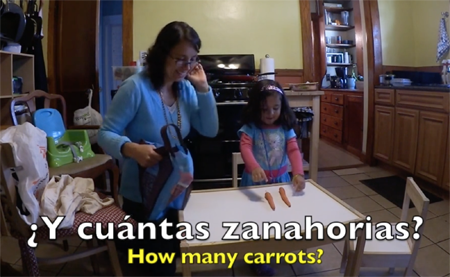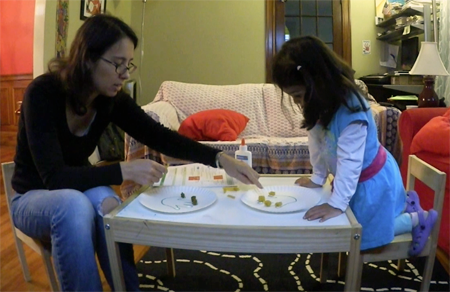The Harvard Family Research Project separated from the Harvard Graduate School of Education to become the Global Family Research Project as of January 1, 2017. It is no longer affiliated with Harvard University.
|
May 31, 2016 Expert Commentary to “Daddy Says This New Math Is Crazy”: Three Tips for TeachersMarlene Kliman
|
FINE Newsletter, Volume VIII, Issue 2
Formula for Success: Engaging Families in Early Math Learning
Voices From the Field
Most parents, whatever their academic background, recognize the importance of math for children’s school and career success; they are eager to support children’s learning at home.1 Yet, today’s parents are likely to have learned arithmetic as a set of memorized facts and algorithms, in contrast to current Common Core–aligned curricula that emphasize children developing the mathematical knowledge needed to devise and explain their own arithmetic strategies.2
The "Daddy Says This New Math Is Crazy" case suggests the need to reconcile two sometimes competing goals:
- For teachers to implement a math curriculum that they (or their district leaders) believe is of great benefit to children but that diverges substantially from traditional arithmetic, and
- For parents to support their children’s math learning and feel confident that their children are gaining a solid math education.
Below are several suggestions for achieving both goals simultaneously, illustrated with examples drawn from Nana y Yo y las Matemáticas, a program in which parents and other caregivers experience a new approach to math alongside their preschoolers over the course of a year.3 Although the program involves younger children, the parallels are many: Most parents initially harbor views that preschool math consists of little more than memorizing the counting sequence and perhaps naming shapes. And at times they question the project approach, which involves exploring shapes, quantities, patterns, measurement, and logic through play, crafts, and active games.
Leverage parents’ mathematical strengths. Look for opportunities to identify curricular content and approaches with which parents are likely to be at least somewhat familiar. Homework assignments based on this material will offer parents an opportunity to draw on their own strengths in helping children with homework. For instance, many parents arrive at Nana y Yo y las Matemáticas already comfortable reciting the counting sequence with their young children:  They count children’s fingers and toes when the children are getting dressed, steps when they are walking, and pieces of food when parents are serving a snack. Few, however, are initially aware of the importance of giving children an opportunity to match, compare, and count objects on their own. From the outset, program facilitators acknowledge and applaud the counting parents already do with children; they also suggest ways to build on this, for instance, by encouraging children to count a set of objects, mix them up, and predict if they will get the same number if they re-count. In this way, parents feel supported and empowered as they use what they already know and do as a springboard.
They count children’s fingers and toes when the children are getting dressed, steps when they are walking, and pieces of food when parents are serving a snack. Few, however, are initially aware of the importance of giving children an opportunity to match, compare, and count objects on their own. From the outset, program facilitators acknowledge and applaud the counting parents already do with children; they also suggest ways to build on this, for instance, by encouraging children to count a set of objects, mix them up, and predict if they will get the same number if they re-count. In this way, parents feel supported and empowered as they use what they already know and do as a springboard.
Make communication with parents the focus of homework. Use the school day for engaging students in learning or practicing with new strategies; for homework, ask them to demonstrate a now-familiar approach to their parents. For instance, if they are grappling with two-digit-by-two-digit multiplication in the classroom, have them demonstrate an approach to solving a two-digit-by-one-digit problem to their parents. This gives parents a glimpse of the strategies children learn at school and a basis for their reassurance that children can, in fact, carry out arithmetic computations successfully and with understanding and meaning.
In Nana y Yo y las Matemáticas, parents report that the whole family benefits when children bring home a math-related craft to share with family members or a math game to play with others at home. Through these mathematical interactions with family members, children come to solidify their understandings, and family members begin to appreciate just how much children are learning and the value of the Nana y Yo y las Matemáticas approach.
Consider capturing children’s classroom problem solving on video. Inviting parents into the classroom might help to allay their concerns, but visits to the classroom during the school day are not feasible for all parents. With near-ubiquitous smartphones, even in low-income communities, teachers can bring snippets of the classroom to parents via occasional videos sent via text.4
In Nana y Yo y las Matemáticas, video is serving as a powerful vehicle for communicating about developmentally appropriate math content and pedagogy. Program facilitators send home one-minute videos to parents via text and use them as a basis for in-the-moment communication with parents.  For example, the parent of a 2-year-old questioned the mathematical value of an activity that involved matching a piece of pasta to each finger, wondering if the child’s time wouldn’t be better spent practicing writing numbers. The program facilitator showed a video of a young child engaged in the same activity and grappling with a more-or-less comparison of her five fingers and three pieces of pasta. The video formed the basis for a reassuring conversation about the role of hands-on experiences with one-to-one-correspondence in developing number sense. The parent emerged with recognition of the value of the activity for her young child.
For example, the parent of a 2-year-old questioned the mathematical value of an activity that involved matching a piece of pasta to each finger, wondering if the child’s time wouldn’t be better spent practicing writing numbers. The program facilitator showed a video of a young child engaged in the same activity and grappling with a more-or-less comparison of her five fingers and three pieces of pasta. The video formed the basis for a reassuring conversation about the role of hands-on experiences with one-to-one-correspondence in developing number sense. The parent emerged with recognition of the value of the activity for her young child.
Final Thoughts
Children benefit from parental engagement in their learning, and many parents want to be involved. In math, an area in which adults often bring a history of rote learning rather than deep understanding, parental engagement can be particularly fraught. If educators are to enlist parents as allies in implementing a new math program, they need to start with parents’ deep desires to see their children succeed and to play a role in helping their children achieve that success.
About the Author:
Marlene Kliman is a senior scientist at TERC, a nonprofit STEM education research and development organization in Cambridge, Massachusetts. Her background is in mathematics, development of mathematical thinking, and educational technology. For more than 30 years, she has designed materials and methods for bringing relevant, engaging, and hands-on math to a wide range of audiences inside and outside of school. She was one of the authors of the first edition of the Investigations math curriculum.
This resource is part of the May 2016 FINE Newsletter. The FINE Newsletter shares the newest and best family engagement research and resources from Harvard Family Research Project and other field leaders. To access the archives of past issues, please visit www.hfrp.org/FINENewsletter.
1 Johnson, J., Rochkind, J., and Ott, A. (2014, April 14). Are we beginning to see the light? Public Agenda http://www.publicagenda.org/pages/math-and-science-ed-2010-full-survey-results; National Center for Families Learning (Spring, 2014). Family Engagement Brief. Retrieved from http://www.familieslearning.org/pdf/NCFL_Family_Engagement_Brief_.pdf
2 National Governors Association Center for Best Practices, Council of Chief State School Officers. (2010). Common core state standards for mathematics. Retrieved from http://www.corestandards.org/Math/
3 Nana y Yo y las Matemáticas, a collaboration between YMCA of Silicon Valley and TERC, builds upon the YMCA’s Early Learning Readiness programs for children from birth to age 5 and their parents, grandparents, and other caregivers. Nana y Yo y las Matemáticas is generously funded by the Heising-Simons Foundation.
4 Smith, A. (2015, April 1). U.S. smartphone use in 2015. Pew Research Center. Retrieved from http://www.pewinternet.org/2015/04/01/us-smartphone-use-in-2015/
